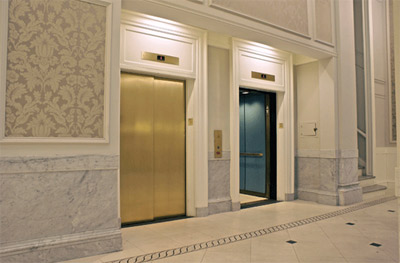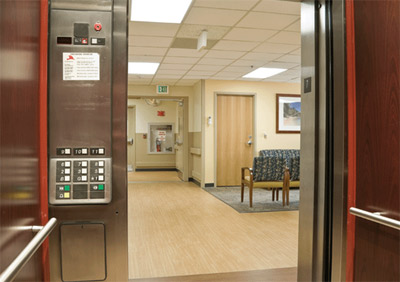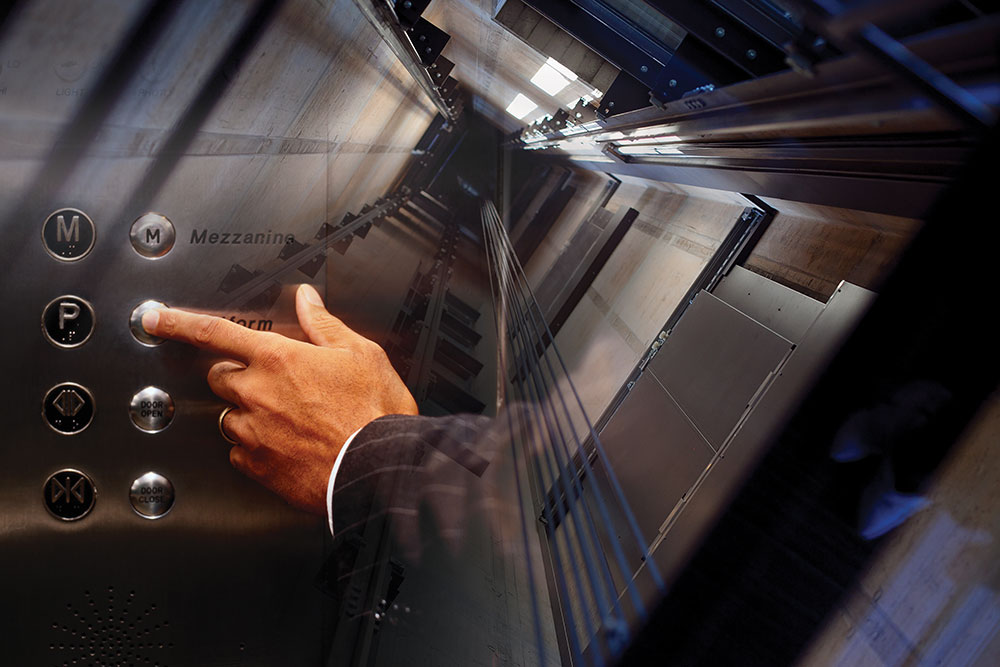Historically, this subject was always a source of confusion to the electrical designers, installers and regulators, as provisions of the Elevator Code have not always been accurately correlated with the National Building Code of Canada (NBCC) and with the Canadian Electrical Code. Fortunately, some provisions for the electrically connected equipment used in conjunction with elevators have been harmonized in the latest editions of the Elevator Code and the NBCC.


Photo 2. Phone in an elevator car — who are you going to call?
Although majority of the electrical requirements of B44 relate to a certified field assembly of the equipment comprising a typical elevator, some of these requirements could impact on the electrical design and installation, as these requirements are extended to the areas outside the scope of B44 into the domain of the NBCC. As it was mentioned at the outset of this article, the NBCC “caught up” with some of these B44 provisions, and such provisions (which before have not been reflected in the National Building Code of Canada) are now transparently articulated in the NBCC for the benefit of the electrical designers and installers. However, there are a few cases where such correlation has not been yet completed.
Let’s discuss a few such examples.
Perhaps, Clause 2.27.1.1.1 of B44 is a good starting point.
It states that “A two-way communication means between the car and a location staffed by authorized personnel shall be provided.” This statement appears to be innocent enough, but what does it actually mean, and how to ensure compliance with this requirement for the purpose of wording “and a location staffed by authorized personnel shall be provided” (e.g., for the purpose of requiring this location outside of the elevator car?)
Where is this mysterious location intended to be, and who are deemed to be “authorized personnel” for the purpose of this requirement?
B44 only explains this requirement in Clause 2.27.1.1.4 for those cases “where the elevator rise is 18 m (60 ft) or more.” This Clause stipulates that if “the elevator rise is 18 m (60 ft) or more,” then “a two-way voice communication means within the building accessible to emergency personnel shall be provided.” This B44 requirement also lists specific conditions for such two-way voice communication means provided in the building. As B44 requires such “two-way voice communication means” to be provided in the building, let’s look at whether the NBCC is consistent with B44 on this requirement. Article 3.2.6.1. of the NBCC describes the application criteria of additional requirements for high buildings. In accordance with these criteria, some buildings are designated as high buildings, when these buildings are more than 36 m (118 ft) high measured between grade and the floor level of the top story. In accordance with this designation, a typical office building would be considered to be a high building only if it exceeded 36 m (118 ft) in height. This NBCC Article assigns a high rise designation to other buildings that have a floor level of a top story at more than 18 m (60 ft) high from grade. This designation applies to a typical building of residential occupancy. The NBCC, however, considers a typical hospital to be a high building, if the patient care area is located above the third story.
So far, so good; but…
How do these NBC “High Rise” designations impact on the B44 requirements to provide “a two-way voice communication means within the building accessible to emergency personnel”? The answer is hidden in Article 3.2.6.7. of the NBCC.
This NBCC Article covers requirements for a very interesting entity called “Central Alarm and Control Facility (CACF).”
This entity is only mandated by the building code for the buildings that are designated as “high buildings,” and a CACF may not be available in a typical building that is not designed and constructed in accordance with provisions of high rise Subsection of the NBCC.
A few editions ago, the NBCC had been amended to reflect provisions for such “a two-way voice communication means within the building accessible to emergency personnel” in Article 3.2.6.7. that covers requirements for CACF. Paragraph (j) of this NBCC Article mandates that a CACF must be provided on the story containing the entrance for firefighter access, and that the CACF must include “means to communicate with telephones in elevator cars, separate from connections to firefighters’ telephones, if elevator cars are required by ASME A17.1/B44, “Safety Code for Elevators and Escalators,”to be equipped with a telephone.” Now we can see that a connection between the B44 requirement and the NBCC provision is made, and that the electrical experts involved in design and installation of the electrically connected life safety equipment would be able to incorporate this B44 requirement under provisions of the NBCC.
What about a situation where a building is not designated as a high building by the NBCC? (What if, for example, this was an office building only 27 m (88.6 ft) high, which is not designed and constructed as a high building and it is not provided with a CACF?). In this case, ability to comply with provisions of B44 “a two-way voice communication means within the building accessible to emergency personnel shall be provided” would be, certainly, highly questionable, and the interpretation on this matter should be discussed with the relevant AHJ.
And, of course, the similar question could be raised by the electrical designers regarding the B44 requirement for “A two-way communication means between the car and a location staffedby authorized personnel shall be provided” in respect to an elevator with the elevator rise less than 18 m (60 ft), as was indicated at the beginning in our discussion of this particular example.
This question could be answered by recognizing the fact that the intent of this B44 requirement may be met by providing means of a two-way communication between a telephone installed in an elevator car and a central station that monitors the building fire alarm system in conformance with the ULC S561. Usually, testing of this two-way communication means between a telephone in an elevator car and authorized personnel of a central monitoring station is done during a coordinated operational test of all electrically connected life safety systems in a building. The AHJ responsible for compliance with this B44 requirement should be also consulted during the design stage of the project.
Let’s touch on another example:
B44 requirement for installation of smoke detectors in an elevator machine room and at each floor served by the elevator, and for automatic return of elevators to a recall level — upon actuation of any of these smoke detectors. Before the publication of the 2010 edition of the NBCC, there was a tangible disconnect between the building code requirements on this subject (the NBCC was silent on requirements of smoke detectors in elevator machine rooms) and B44 provisions, and such inconsistency had been creating a significant “headache” to the electrical designers, installers and regulators.
Nevertheless, the new edition of the NBCC has addressed this issue (but partially). Sentence 3.2.4.12.(1)(g) of the NBCC now requires smoke detectors in elevator machine rooms, and Sentence 3.2.4.12.(4) mandates automatic recall of the elevators served by the elevator machine room in which the actuated smoke detector is installed. So, in this respect, correlation between the B44 and the NBCC has been completed.
However, requirements of Clause 2.27.3.2.2(a) of the B44 — to install smoke detectors at each floor served by the elevator, and the provision of Clause 2.27.3.2.3 of the B44 — to recall to the designated level all elevators that serve the floor where the actuated smoke detector is located, are not accurately reflected by the NBCC. Sentence 3.2.4.15.(1) of the NBCC only mandates installation of smoke detectors in the elevator lobbieson the recall level, and it requires that the elevators will be automatically recalled to an alternate floor level upon actuation of these smoke detectors. This, latter requirement of the NBCC is further relaxed if the recall level is sprinklered. Thus, it could be seen that a correlation between the Elevator Code and the NBCC in respect to the installation of smoke detectors on each floor area in front of the elevators and elevator recall, is not entirely completed.
Thus, the designers might have to continue to experience “headaches” on this subject. Some local building by-laws have become more proactive on this issue. For example, the Vancouver Building By-law has been amended so as to mandate installation of smoke detectors in each floor area in front of the elevator or elevators and to mandate automatic emergency return to the recall level of the elevators served by the floor in which the smoke detectors (installed in front of these elevators) have been actuated. This By-Law has been also amended to require an automatic return of the elevators to an alternate recall level, when the smoke detectors mentioned above are actuated on the recall level.
So, the conclusion is:
The electrical designers and installers — beware of these remaining inconsistencies between two codes and consult your appropriate AHJs who have jurisdictional authority for administration of the applicable codes and standards.
Ark Tsisserev has been an electrical safety regulator for more than 25 years and has recently retired from the city of Vancouver as chief electrical inspector. Ark is a past president of the Canadian Section of the IAEI. He is a registered professional engineer with a master’s degree in electrical engineering. He is currently the chair of the Technical Committee for the Canadian Electrical Code and is representing the CE Code Committee on the CMP-1 of the National Electrical Code.












Find Us on Socials